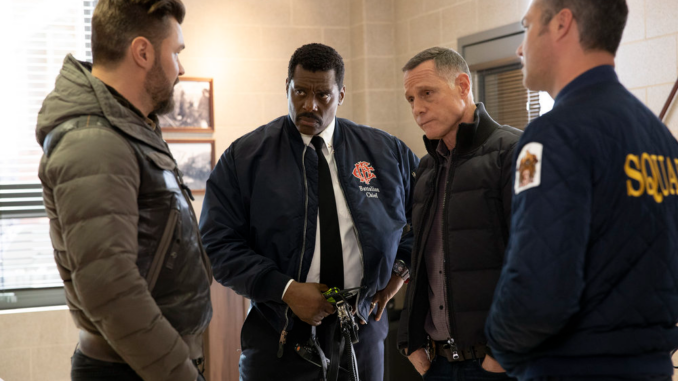
One Chicago’s Latest Crossover Didn’t Need To Toy With My Emotions Like That
The “One Chicago” universe is known for its gripping storylines, intense action, and the deep emotional connections it fosters with its viewers. However, the latest crossover event has left many fans feeling emotionally drained, questioning the necessity of such a rollercoaster of feelings. The writers masterfully crafted a narrative that tugged at every heartstring, but did they go too far?
The Emotional Gauntlet: A Crossover of Heartbreak
The crossover event seamlessly blended the worlds of “Chicago Fire,” “Chicago P.D.,” and “Chicago Med,” creating a unified narrative that tackled a complex and emotionally charged situation. While the seamless integration was impressive, the sheer volume of emotional trauma left many viewers feeling overwhelmed.
High-Stakes Scenarios and Personal Losses
The crossover didn’t shy away from high-stakes scenarios, putting beloved characters in life-threatening situations. This constant barrage of danger and the potential for loss created a sense of unrelenting anxiety.
- Life-Threatening Emergencies: The medical drama took center stage, with critical patients and life-or-death decisions that left viewers on the edge of their seats.
- Dangerous Investigations: The police drama added layers of tension, with investigations that put characters in harm’s way, blurring the lines between professional duty and personal safety.
- Firehouse Peril: The fire drama brought the physical danger, with rescue operations and hazardous situations that tested the courage and resilience of the firefighters.
Emotional Vulnerability and Character Trauma
Beyond the physical danger, the crossover delved deep into the emotional vulnerabilities of the characters. Personal traumas, relationship conflicts, and moral dilemmas were all brought to the forefront, creating a sense of emotional overload.
- Relationship Conflicts: Existing relationships were tested, and new conflicts arose, adding layers of emotional complexity to the already intense narrative.
- Moral Dilemmas: Characters were forced to make difficult choices, grappling with moral dilemmas that challenged their values and beliefs.
- Personal Trauma: Past traumas resurfaced, and new traumas were inflicted, leaving characters emotionally scarred and vulnerable.
The Impact on Viewers: A Collective Emotional Rollercoaster
The intense emotional journey of the crossover left a significant impact on viewers, who took to social media to express their feelings of heartbreak, frustration, and emotional exhaustion.
Social Media Outpouring: Tears and Frustration
Social media platforms were flooded with posts from viewers expressing their emotional reactions to the crossover. Many shared their feelings of heartbreak, frustration, and disbelief at the events that unfolded.
- Hashtag Trends: Crossover-related hashtags trended on social media, with viewers sharing their reactions and engaging in discussions about the episode.
- Emotional Memes: Memes and GIFs depicting emotional reactions to the crossover circulated widely, capturing the collective feeling of heartbreak.
- Fan Theories and Speculations: Viewers engaged in passionate discussions and speculations about the future of their favorite characters.
The Question of Necessity: Did They Go Too Far?
While the emotional impact of the crossover was undeniable, many viewers questioned the necessity of such a relentless barrage of emotional trauma. They wondered if the writers had gone too far in their pursuit of dramatic impact.
- Emotional Fatigue: Some viewers expressed feelings of emotional fatigue, feeling overwhelmed by the constant barrage of emotional trauma.
- Questioning the Balance: Viewers questioned the balance between dramatic impact and emotional well-being, suggesting that the crossover had tipped too far in the direction of trauma.
- Desire for Hope and Resilience: Some viewers expressed a desire for more moments of hope and resilience, feeling that the crossover had focused too heavily on the negative aspects of the characters’ lives.
The Value of Emotional Storytelling: A Double-Edged Sword
The “One Chicago” crossover highlighted the power of emotional storytelling, but also underscored the potential for it to become overwhelming.
The Power of Emotional Connection
Emotional storytelling is a powerful tool for connecting with viewers and creating a lasting impact. The crossover effectively used emotional storytelling to create a sense of investment and engagement.
- Character Development: The emotional challenges faced by the characters provided opportunities for character development and growth.
- Relatability: The emotional struggles of the characters resonated with viewers, who could relate to their experiences.
- Sense of Community: The shared emotional experience of watching the crossover created a sense of community among viewers.
The Risk of Emotional Overload
However, the crossover also demonstrated the risk of emotional overload. The relentless barrage of emotional trauma can leave viewers feeling drained and disengaged.
- Desensitization: Overexposure to emotional trauma can lead to desensitization, reducing the impact of future emotional storylines.
- Alienation: Some viewers may feel alienated by the constant focus on negative emotions, preferring stories that offer more hope and positivity.
- Ethical Considerations: Writers must consider the ethical implications of using emotional trauma as a storytelling device, ensuring that it is used responsibly and thoughtfully.
Looking Ahead: Finding Balance and Moving Forward
The “One Chicago” crossover served as a reminder of the power and potential pitfalls of emotional storytelling. As the series moves forward, it’s essential to find a balance between dramatic impact and emotional well-being.
Prioritizing Character Resilience
Future storylines should prioritize character resilience, showcasing the ability of the characters to overcome adversity and find hope in the face of challenges.
Balancing Drama with Hope
Writers should strive to balance dramatic storylines with moments of hope, positivity, and emotional relief.
Engaging in Responsible Storytelling
The “One Chicago” team should continue to engage in responsible storytelling, considering the emotional impact of their narratives on viewers.
In conclusion, the latest “One Chicago” crossover delivered a powerful emotional punch, leaving viewers reeling. While the emotional intensity was undeniable, it also raised questions about the balance between dramatic impact and emotional well-being. As the series moves forward, it’s crucial to find a balance that honors the power of emotional storytelling while prioritizing the well-being of its viewers.
